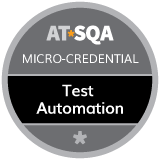AT*SQA Micro-Credentials - Test Automation Overview

Test Automation Overview Micro-Credential
Test automation is a method of testing that uses automated test scripts rather than manual test cases. The test scripts are small software programs written in a scripting or programming language that accomplish the goals of a test by controlling the inputs to a software module and verifying that the results match the expectations.
In its simplest form, a script mimics the user interaction with the system under test (SUT) and is programmed to report any variances from the expected behavior. This Test Automation Overview micro-credential shows you have a fundamental understanding of test automation so you can begin to contribute in this area.
This is the first micro-credential in the Test Automation AT*SkillStack™. When you earn Test Automation Overview plus Test Automation Implementation, Test Automation Tools and Solutions, and Test Automation Transitions, you are eligible for the AT*SQA Test Automation certification at no additional charge.
Learn Test Automation through AT*Learn Training
Test Automation in Software Development: What QA Teams Need to Know
Test automation has grown increasingly popular within the software development industry. This approach allows software development and quality assurance (QA) teams to expedite their testing processes and deliver more reliable applications. Compared to conventional manual testing methods, test automation has the potential for time efficiency, cost savings, and enhanced software quality.
AT*SQA's free Test Automation body of knowledge and optional AT*Learn training webinar give QA teams basic knowledge about test automation. Below are some points related to the body of knowledge and webinar.
Test automation involves utilizing tools and frameworks that automate test execution with minimal manual intervention. With automated tests, teams can test how different parts of the software work in tandem, streamline the process of finding bugs and errors, and improve the overall software performance.
Automation testing tools provide the capability to author, execute, and manage tests effectively. A range of commercial and open-source tools are available, and the choice depends on the project requirements, budget, and team expertise.
Test automation comes with several notable benefits. One primary advantage is speed. Automated tests are capable of executing repetitive tasks and complex test scenarios faster than human testers. As software development practices such as Agile and DevOps emphasize rapid releases, speed becomes crucial.
Another key benefit is reliability. Manual testing can be error-prone, given the repetitive nature of the tasks involved. In contrast, automated tests perform the same steps precisely each time they are executed, eliminating the risk of human error. Additionally, these tests can run overnight or over the weekend, freeing up human testers to focus on more complex tasks.
Accuracy and coverage are also enhanced with automation. Automated tests can cover thousands of complex scenarios in every test run, ensuring a higher level of coverage. They can execute tests with different data sets, user environments, and configurations, offering an impressive breadth and depth of testing.
Despite its clear advantages, test automation does come with its challenges. Firstly, it requires an initial investment in terms of money, time, and resources. Identifying the right tool, setting up the framework, writing scripts, and training the team can be time-consuming and costly.
Secondly, test automation is not a silver bullet. It cannot replace all manual testing. Some tests are too complex or require too much setup and teardown to be effectively automated. In other cases, the human perspective is essential - for example, to judge usability or aesthetics. Therefore, it is crucial to strike a balance between manual and automated testing based on the project's requirements.
Moreover, maintaining automated tests can be challenging as the software evolves. Test scripts need to be continually updated to align with new features or changes in the software. This can lead to a high maintenance overhead if not managed effectively.
The final challenge is the skill gap. Automation requires a certain level of technical skills, which not all QA professionals may possess. Therefore, there may be a need for training or hiring new staff with the necessary skills.
Test automation has the potential to transform software testing, making it faster, more reliable, and more comprehensive. However, it's not without its challenges, including the initial investment required, the need for ongoing maintenance, and the potential skills gap.
By being aware of these challenges and proactively managing them, organizations can harness the full potential of test automation. They can create a blended approach to testing that combines the speed and precision of automation with the intuition and contextual understanding of manual testing. In this way, test automation can become an integral part of a comprehensive and effective software quality assurance strategy.
AT*SQA's free body of knowledge provides helpful insights into the different methods, benefits, and potential risks involved in test automation. For those who prefer to watch a presentation on test automation, AT*SQA also offers the $7.99 per month AT*Learn software testing training area.
After you have learned about test automation, prove your knowledge with the Test Automation micro-credential. Like all of AT*SQA's micro-credentials, upon passing, the micro-credential will appear on your profile in the Official U.S. List of Certified & Credentialed Software Testers™ and give you points toward your Testing Tiers® software tester ranking level.
AT*SQA Software Testing Micro-Credentials
Agile Testing Certification AT*SkillStack™
Consists of the following AT*SQA Micro-Credentials:
API Testing Certification AT*SkillStack™
Consists of the following AT*SQA Micro-Credentials:
Test Automation Certification AT*SkillStack™
Consists of the following AT*SQA Micro-Credentials:
Testing Essentials Certification AT*SkillStack™
Consists of the following AT*SQA Micro-Credentials:
Other Micro-Credentials
Testing Using The Cloud